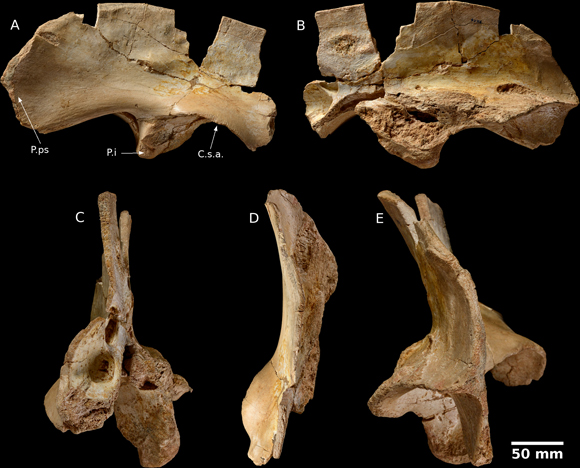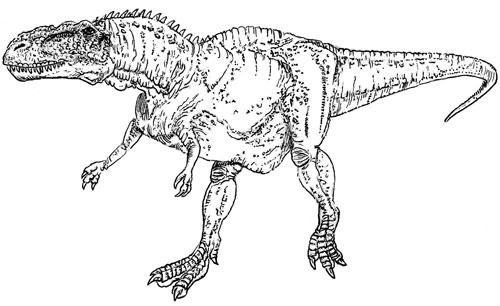Just How Successful were the Abelisaurs in Africa?
A partial ilium collected from the famous Kem Kem Beds of eastern Morocco hints that those enigmatic abelisaurids may have been widely distributed (both geographically and temporally) in Africa. Writing in the on-line academic journal “PLOS One” scientists including researchers from the University of Southampton, Muséum d’Histoire Naturelle de Marrakech (Morocco), the University of Debrecen (Hungary) and the Natural History Museum (Paris), report on a fragmentary ilium bone, collected in 2007 and sourced via the fossil dealer network that indicates that abelisaurids were present in Morocco around 100 million years ago.
This fossil find adds to the growing evidence to suggest that abelisaurids were the dominant predators in Africa in the Late Cretaceous.
The Fragmentary Ilium – Abelisaurid Fossil Remains
Picture credit: PLOS One
Abelisaurid Fossil Specimen (MHNM KK 04)
The picture (above), shows various views of the ilium fossil. The pieces have been prepared and assembled and now form part of the collection of the Natural History Museum of Marrakech. The ilium is shown in (A) lateral view, (B) medial view, (C) anterior view, (D) dorsal view and posterior view (E). In the photograph the scale bar is given as 50 mm, however, in the accompanying notes, the scale is reported as 10 cm, it is therefore difficult to estimate the size of the individual theropod without confirmation of the size of the fossils.
An Illustration of a Typical Theropod Dinosaur (Abelisauridae)
Picture credit: Everything Dinosaur
From the Aferdou Region of Morocco
The fossils are believed to come from the Aferdou region, near the locality of Gara Sbaâ (eastern Morocco), based on biostratigraphical analysis, the terrestrial sandstones in this region are thought to date from the Lower Cenomanian faunal stage of the Upper Cretaceous. Dinosaur fossils from the Kem Kem Beds represent either theropods (most numerous), or sauropods.
In the research paper, the authors state that no ornithischian body fossils are known from the Kem Kem Beds. However, most of the material is fragmentary, represents deposits that have been reworked and the thriving fossil trade is now playing a significant role in the local economy. Commercial fossil hunters are affecting the quality of the research that can be carried out on the fossil bearing strata.
The scientists conclude that the ilium is likely to represent an abelisaurid, but no genera has been specified and no new species named. Based on the shape of the bone, the specimen (MHNM KK04), is assigned to the clade Abelisauria.
Abelisaurid Apex Predators
This adds to the growing evidence to indicate that abelisaurids may have been the dominant land predators in Late Cretaceous Africa. In 2017, Everything Dinosaur reported on the discovery of a fragment of jaw bone found in a Moroccan phosphate mine that led to the naming of a new species of abelisaurid – Chenanisaurus barbaricus. C. barbaricus may belong to an as-yet undescribed family of abelisaurs unique to Africa and its fossils are around thirty million years younger than the ilium bone from the Aferdou region.
To read about Chenanisaurus barbaricus: The Last Dinosaur in Africa.
For an article that looks at why the Late Cretaceous of Africa might have been home to such a large number of predators: Why So Many Large Predators in Cretaceous Africa?
The scientific paper: “An abelisaurid (Dinosauria: Theropoda Ilium from the Upper Cretaceous (Cenomanian) of the Kem Kem Beds, Morocco” by Slimane Zitouni, Christian Laurent , Gareth Dyke and Nour-Eddine Jalil published in PLOS One.
Visit the Everything Dinosaur website: Visit Everything Dinosaur.









Leave A Comment